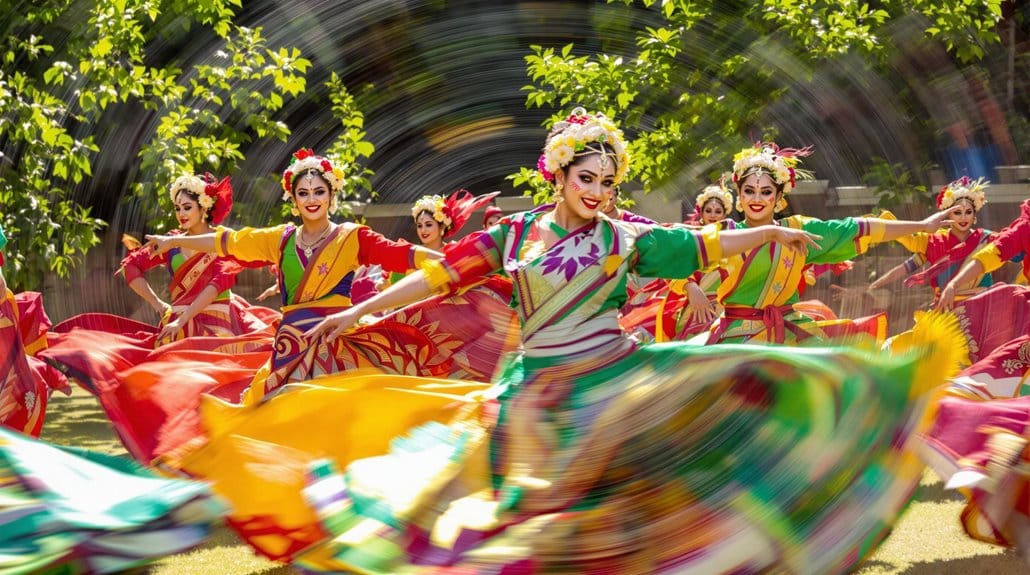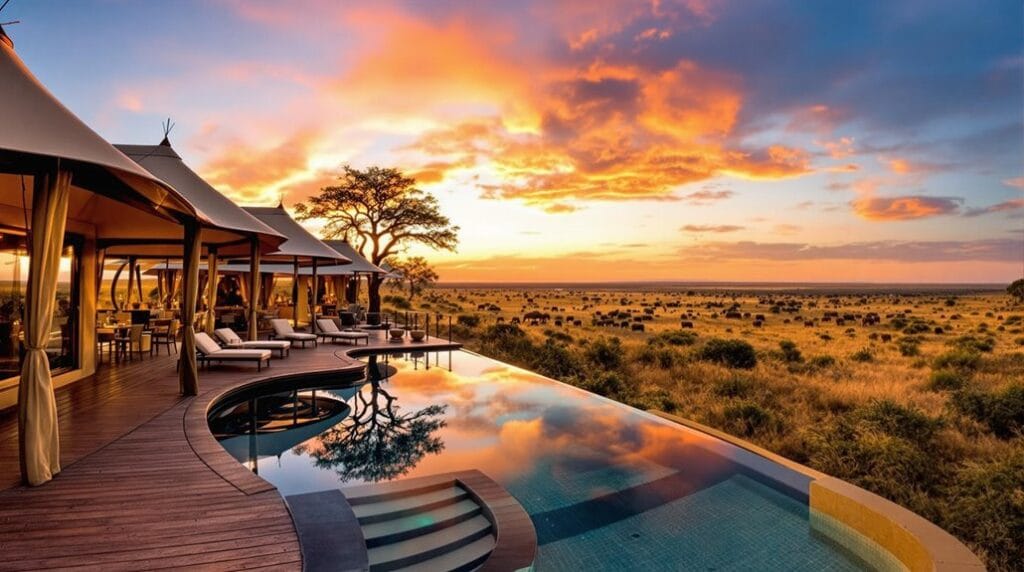Imagine witnessing a Zulu dance during a traditional wedding, where each movement tells a story of heritage and community. As you observe the intricate footwork and rhythmic clapping, you might start to wonder how these vibrant expressions have evolved over time. What role does music play in enhancing these performances, and how do regional styles differ across the continent? Understanding the nuances behind Africa's dance traditions reveals not just cultural significance but also a dynamic interplay of history and modernity that shapes their ongoing legacy.
Key Takeaways
- African dance embodies diverse community lives and beliefs, with unique traditions reflecting spiritual, agricultural, and social practices across sub-Saharan Africa.
- Performances often emphasize communal participation, featuring rhythmic movements in circular or linear formations that foster a sense of belonging.
- Drumming and music play a crucial role, establishing a symbiotic relationship that energizes performances and enhances the emotional experience of dance.
- Regional variations highlight distinct characteristics, blending traditional sounds with contemporary influences like hip-hop, ensuring cultural narratives evolve with modernity.
- The future of African dance thrives on adaptation, leveraging social media for global reach while maintaining cultural heritage through institutional support and community engagement.
Overview of African Dance
When you explore the world of African dance, you'll discover it's not just a series of movements; it's a rich tapestry woven from the lives, beliefs, and histories of diverse communities across sub-Saharan Africa.
Each community has its own distinctive African dance traditions, reflecting unique cultural expressions tied to their spiritual, agricultural, and social practices.
Traditional dance serves as a crucial link to the past, with rhythmic movements that convey stories and emotions. As you watch dancers perform, you'll notice the polycentrism and polyrhythm that define these art forms, where full-body articulations and distinct shoulder and hip movements create a mesmerizing spectacle.
Dance is often performed in circular or linear formations, fostering a profound sense of community and belonging.
The costumes and masks used in these performances carry deep cultural significance, often crafted from traditional fabrics that symbolize social status. They enhance the storytelling aspect, allowing each performance to resonate with layers of meaning.
In experiencing these vibrant traditions, you connect not just with the art of dance, but also with the heart and soul of the cultures they represent, reminding you of the power of movement as a universal language.
Historical Context and Evolution
As you explore the origins of traditional African dance, you'll find its deep roots intertwined with daily life and spiritual practices across sub-Saharan Africa.
However, the arrival of European imperialism disrupted these traditions, leading to a complex fusion of local and foreign influences that reshaped dance forms.
This historical evolution not only highlights the resilience of cultural identity but also reflects the dynamic interplay between tradition and change.
Traditional Dance Origins
Traditional African dance serves as a vibrant expression of cultural identity, intricately woven into the fabric of daily life and spiritual practices. You'll find these dances rooted in ancient choreographic traditions, essential for community rituals and storytelling. Each movement carries layers of meaning, reflecting the rich cultural heritage of diverse African cultures.
| Element | Significance |
|---|---|
| Community Functions | Strengthens social bonds |
| Spiritual Practices | Connects with ancestors |
| Storytelling | Preserves histories and values |
| Rhythmic Drumming | Drives the pace and energy |
Traditionally, African dances were local and oral, serving specific purposes, whether honoring a harvest or celebrating a rite of passage. Passed down through generations, these dances emphasize maintaining original forms, ensuring cultural sustainability. While the evolution of traditional dance reflects historical changes—like the impact of colonialism—it continues to adapt, resonating with contemporary expressions of African culture. You'll discover that the rhythmic drumming and vibrant movements invite not just participation but also belonging, creating a bridge between the past and present.
Colonial Influence Impact
How did colonialism reshape the landscape of African dance? Colonialism imposed foreign values that transformed traditional dances, often stripping them of their original spiritual and communal significance.
European aesthetics infiltrated these rhythmic expressions, leading to hybrid forms that blended indigenous styles with Western influences. This fusion created new genres but also lessened the depth of powerful storytelling inherent in traditional dances.
As the African Diaspora emerged from this tumultuous history, it became a vessel for spreading African rhythms across the globe, influencing music genres throughout the Americas and beyond.
Yet, despite colonial disruptions, traditional dances continue to serve as essential expressions of cultural identity. In post-colonial contexts, these dances often reclaim lost narratives, acting as acts of resistance against the lingering shadows of imperialism.
You might find that in these vibrant movements, the essence of resilience pulses through. Each step, beat, and gesture tells a story—your story.
Engaging with these dances invites you into a community that honors both its roots and its evolution, reminding you that cultural heritage remains a powerful force in shaping identity and belonging.
Characteristics of Dance Styles
African dance styles are rich and varied, showcasing a remarkable array of characteristics that set them apart from other cultural forms. These dances are often marked by polycentrism, where different body parts move independently yet harmoniously, creating intricate visual patterns. You'll notice the full-body articulations, especially pronounced shoulder and hip movements, reflecting the athleticism required of performers.
Many dances emphasize communal participation, often performed in circular or linear formations that foster a sense of belonging among participants. The storytelling aspect of these dance styles allows you to connect with the narratives and histories being expressed through movement.
Each region brings its unique flair; for instance, North African dance features intricate hand movements, while Southern African dances are characterized by rhythmic stomping and dynamic footwork.
Traditional instruments, such as drums and flutes, play an essential role in these performances, dictating their rhythm and energy. As you immerse yourself in these vibrant expressions, you'll find that each dance isn't just a performance but a communal celebration of identity, culture, and shared experience.
Music and Instruments in Dance
When you listen to African dance music, you can't help but notice the rhythmic instrumentation that drives each performance.
The connection between drumming and dance becomes clear as the vibrant beats propel the dancers' movements, creating a dialogue that's both energetic and deeply rooted in tradition.
As you explore the blend of traditional and contemporary sounds, you'll see how these musical elements shape the emotional landscape of the dance, enriching the cultural narrative being expressed.
Rhythmic Instrumentation Importance
Rhythmic instrumentation plays an essential role in shaping the vibrant dance traditions found across the continent. In traditional African music, the heart of the performance lies in its polyrhythmic structures, where multiple rhythms intertwine, creating a rich tapestry of sound. Here, the djembe drum stands out, not just as an instrument but as a crucial communication tool between dancers and drummers. This dynamic interplay fuels the energy of the dance, making each movement resonate with the rhythms produced.
As you witness a performance, you'll notice how percussive instruments form the backbone of the music, encouraging audience interaction and participation. Traditional African music often incorporates flutes and vocal chants, enhancing the immersive auditory experience that complements the dance.
The rhythmic instrumentation doesn't just accompany the dancers; it dictates their movements, creating a symbiotic relationship where both music and dance thrive together. This communal experience fosters a sense of belonging, inviting everyone to engage, whether as a dancer or an audience member.
Ultimately, the vibrant rhythms echo the culture and spirit of African communities, uniting people through the universal language of music and movement.
Drumming and Dance Connection
Connecting drumming and dance creates a vibrant dialogue that pulses through the heart of African performance traditions. In this dynamic interplay, drumming serves as the heartbeat of African music, embodying the rhythmic structures that define each dance form. As you immerse yourself in these performances, you'll notice how traditional instruments like the djembe craft intricate rhythms that inspire movement, inviting dancers to respond with vibrant expression.
The energy from the drummers fuels the dancers, creating a synergy that encourages spontaneity and improvisation. This connection isn't merely physical; it's a shared experience, where the musicians' beats resonate with the dancers' bodies, forging a bond that transcends words.
As you listen, you might hear chants woven into the fabric of the music, enhancing the communal atmosphere and deepening your sense of belonging. In African dance, every beat, every step, speaks volumes about culture, history, and identity.
The polyrhythmic structures amplify the complexity of the dance, urging you to participate in this rich narrative. As you engage with these traditions, you'll find yourself not just an observer, but an essential part of the rhythmic tapestry that celebrates life itself.
Traditional Versus Contemporary Sounds
Africa's dance traditions showcase a fascinating evolution in sound, reflecting both the richness of ancient practices and the dynamism of contemporary influences. Traditional African music is defined by its polyrhythmic structures, where multiple rhythms intertwine, resulting in a vibrant auditory experience that elevates the dance. Central to this is the drum, particularly the djembe, which drives the rhythm and fosters a dialogue between dancers and musicians.
In contrast, contemporary African dance infuses traditional sounds with modern genres. You'll find electronic instruments and hip-hop beats blending seamlessly, showcasing the evolving musical landscape. This fusion creates a unique atmosphere, allowing dancers to connect with both heritage and modernity.
| Traditional Sounds | Contemporary Sounds |
|---|---|
| Polyrhythmic drum patterns | Hip-hop beats |
| Live instruments like djembe | Electronic instruments |
| Chanting and vocalizations | Modern vocal styles |
| Flutes and kalimbas | Synthesizers and samples |
| Cultural narratives in performance | Global influences in movement |
This transformation not only celebrates the past but also invites you to explore new dimensions of dance, fostering a sense of belonging in a vibrant, ever-evolving community.
Costumes and Cultural Significance
Costumes in African dance are more than just vibrant decorations; they serve as powerful symbols of cultural identity and social status. Each costume you see is a tapestry woven from traditional fabrics, colorful textiles, and animal pelts, often loaded with meaning. They protect against evil spirits and proclaim the wearer's societal role within various cultural contexts.
You'll notice that the design and style of these costumes can vary considerably, shaped by local customs, historical influences, and the shadows of colonialism. Masks often play an essential role, embodying spirits or animals, and are frequently donned by religious leaders to deepen the cultural narrative during performances.
In many ways, the costumes aren't merely aesthetic; they enhance storytelling. Each specific dance comes with distinct attire that conveys rich narratives, addressing traditional concerns like fertility while also tackling contemporary issues such as social justice.
Through these vibrant ensembles, dancers become storytellers and teachers, ensuring that the cultural significance of African dance resonates across generations. When you engage with these traditions, you're not just witnessing a performance; you're stepping into a world where history, identity, and community come alive.
Regional Dance Traditions
Regional dance traditions across the continent showcase the rich tapestry of cultural expressions found in diverse communities. Each region brings forth unique dances, reflecting its historical narratives and social values.
In Southern Africa, for instance, you'll notice the lively footwork that emphasizes rhythm and community togetherness, embodying the spirit of celebration and resilience.
In West Africa, dances like Makossa from Cameroon blend traditional and modern elements, inviting everyone to join in the energetic hip-swaying movements.
Meanwhile, in Central Africa, the Tchondo dance fills festivals with joyous foot-stomping and spirited gestures, serving as a manifestation of cultural identity.
Gabon's Ekang dance, performed by the Fang people, highlights the connection between the earthly and spiritual domains during important ceremonies, showcasing elaborate costumes that enhance the visual storytelling.
Equally, Bwiti dance plays an important role in spiritual practices, with trance-like movements paired with rhythmic drumming that guide participants through initiation rites.
These regional dances aren't just performances; they're living traditions that foster belonging and connection, weaving together individuals and communities through shared cultural experiences, marking the heartbeat of Africa's vibrant heritage.
The Future of African Dance
As we move into the future, African dance continues to evolve, blending traditional rhythms with contemporary influences that captivate younger generations and global audiences alike. This evolution is often reflected in new interpretations performed by artists who draw inspiration from their roots while embracing modern styles.
The rise of social media and online platforms plays a significant role in this transformation, allowing dancers to showcase their work and connect with diverse cultural audiences around the world. These innovative forms resonate deeply, fostering a sense of belonging among those who engage with them.
The global popularity of Afrobeats and viral dance challenges highlights the significance of cultural exchange, where African and international dancers collaborate and inspire each other. As these traditions are passed down through generations, they adapt, guaranteeing that the essence of African dance remains vibrant and relevant.
Institutions dedicated to preserving and promoting African dance are crucial to maintaining its cultural significance. By supporting artists and educators, they guarantee that this rich heritage continues to thrive, inviting you to join in celebrating the dynamic future of African dance as it charts new paths while honoring its storied past.
Frequently Asked Questions
What Is the Traditional Dance of Africa?
When you explore traditional dance of Africa, you discover a tapestry of styles rich in cultural significance.
Each region boasts unique dance rituals that reflect its heritage, using vibrant movements that celebrate community events.
Music integration is essential, with drums providing rhythm that unites dancers.
From harvest festivals to spiritual ceremonies, these dances embody the essence of belonging, showcasing regional variations that connect you deeply to the spirit of African communities and their traditions.
Is Zangbeto Dance Real?
Is Zangbeto dance real? Absolutely! Rooted in Yoruba origins, this vibrant performance symbolizes the community's connection to their ancestors.
As you watch the dancers in their elaborate costumes, you'll feel the energy of the rituals that chase away evil spirits. Each vigorous movement and rhythmic beat fosters a sense of belonging, reminding you that cultural heritage thrives in unity and celebration.
Zangbeto dance isn't just art; it's a living tradition that binds people together.
What Are Five Features of African Dance?
When you explore African dance, you'll notice its unique rhythm patterns that energize every movement. Each dance holds cultural significance, often reflecting community values and history.
The dance attire, adorned with vibrant fabrics, enhances visual storytelling elements, making performances enthralling. Community participation is essential, as it fosters connections among dancers and spectators.
What Are Three Important Principles of Dances From the African Continent?
You'll find that the principles of African dance are as rich and vibrant as a sunset over the savannah.
First, the cultural significance of dance serves as a heartbeat for community involvement, fostering unity.
Next, rhythmic patterns intertwine with storytelling elements, narrating tales that resonate through generations.
Conclusion
As you immerse yourself in Africa's vibrant dance traditions, you'll discover a world where every movement tells a story, echoing the heartbeat of a continent rich in culture. These dances aren't just performances; they're living expressions of community, history, and identity. With each step and rhythm, you're invited to join a dialogue that spans generations. So, will you step into this dance and let the rhythm of Africa resonate within you?








